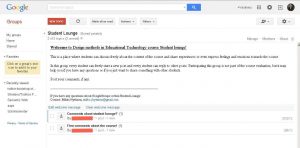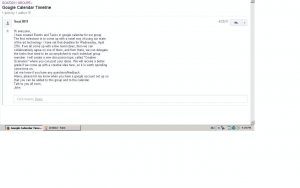Description
In the 21st century modern education is becoming increasingly complex due to the technological environment within which it operates. This new environment offers exciting new possibilities but also raises challenges. Low cost, ubiquity, accessibility and ease of use are all potential affordances, which are making social media technologies an attractive option for transforming teaching and learning environments. Some Web 2.0 technologies and services that are contributing to the higher education domain are blogs, microblogs, wikis, multimedia sharing services and content syndication through RSS, podcasting and content tagging services, social networking sites and other social software.
Link to example artifact(s)
State-of-Art Technologies
Dr. Vasileios Paliktzoglou and Dr. Jarkko Suhonen introduced the Google Educational Applications tools as a collaborative platform to support group work in one of the course modules during the State-of-Art Technologies in an Education online course at the School of Computing, University of Eastern Finland. The students received a general introduction as to the use of Google Educational Applications. Detailed instructions were provided to the students on how to use the tools via a set of practical tasks and video tutorials. The next step was to launch the group work. The topics given to the groups were related to the content of the State-of-the-Art Technologies in Education course. The following teams were formed: Team 1 (Wilostar3D-Virtual worlds); Team 2 (Web 2.0 technologies and social software); Team 3 (Aplusix – software for learning arithmetic and algebra calculations); Team 4 (Interactive whiteboard); Team 5 (Sura Ya Ukimwi – a story based e-learning environment to learn about HIV/AIDS) and Team 6 (Greenfoot – environment for creating visual exercises to support learning about programming).
The aim of the group work was to design a concrete scenario using the team’s state-of-the-art technology in real life learning settings. After selecting the teams, the groups started their work, which was supported by Google Educational Applications. A team leader was nominated by each team and his/her task was to ensure that all the outlined tasks and milestones were met timeously. We expected that each group and individual group members would use Google Educational Applications during the group work in the following manner:
- Gmail to stay in touch with other members;
- Google Groups to discuss possible strategies/issues regarding the project;
- Google Docs to collaboratively write their assignment;
- Google Calendar to set up milestones and deadlines for their project;
- Google Notebook to record important notes and bookmarks about their assignment;
- GTalk to facilitate the opportunity for synchronous contact/collaboration/meeting;
- and lastly Google Sites in order to present and reflect on the work done for their project.
It is worth mentioning that the instructor was constantly supporting, stimulating and facilitating collaboration on a day to day basis. Part of the learning strategy was to motivate students to collaborate, share resources and discuss their work using Google Educational Applications. For example, each of the students had to post at least 3 post per week related to the topic of their group work as part of the collaboration process and then reply to the posts of the other group members. In this way students became active participants in Google Applications and participation was rewarded as part of the course marks. For the duration of the course the instructor was responsible for constantly presenting the student groups with relevant literature in the form of posts including videos, links to books, articles etc.
Link to scholarly reference(s)
Paliktzoglou, V., Stylianou, T., & Suhonen, J. (2014). Google educational apps as a collaborative learning tool among Computer Science learners In P. Ordóñez de Pablos, R. D. Tennyson and M. D. Lytras (eds.), Assessing the Role of Mobile Technologies and Distance Learning in Higher Education. Hershey, PA: Information Science.
Citation
Paliktzoglou, V. (2015). Use google educational apps to foster online collaborations. In B. Chen & K. Thompson (Eds.), Teaching Online Pedagogical Repository. Orlando, FL: University of Central Florida Center for Distributed Learning. https://topr.online.ucf.edu/use-google-educational-apps-to-foster-online-collaborations/.

